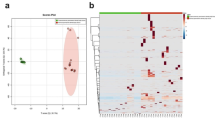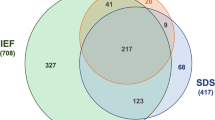Abstract
Introduction
For dental treatment, dentin regeneration is required after a tooth injury with dental pulp exposure. The effects of the water-soluble matrix (WSM) extracted from the nacreous layer of the bivalve Pinctada maxima on human dental pulp cells in vitro were challenging and useful for clinical application.
Material and methods
The biological activity of the STRO-1-positive human dental pulp cells in response to WSM compared to Dulbecco’s modified Eagle medium (DMEM) as a normal control was monitored. The cell survival rate was analyzed by the 3-(4,5-dimethylthiazol-2-yl)-2,5-diphenyltetrazolium bromide (MTT) assay. Proteomic profiles among inducers and noninducers with time dependency were compared by using sodium dodecyl sulfate-polyacrylamide gel electrophoresis combined with liquid chromatography-tandem mass spectrometry (GeLC-MS/MS).
Results
The human dental pulp cells cultured in nacreous WSM exhibited higher relative cell viability than those in DMEM with similar morphological appearance. Significant changes were found in the relative abundance of 44 proteins in cells after exposure to WSM for 2 weeks. They play a role in cell adhesion, cell proliferation, metabolic process, signal transduction, stress response, transcription, translation, and transport.
Conclusion
These results indicate that WSM of P. maxima has the ability to induce proliferation of human dental pulp cells.
Clinical relevance
This finding initiated the study to evaluate the suitability of nacre as biomaterial for dentistry.




Similar content being viewed by others
References
Murray PE, Garcia-Godoy F, Hargreaves KM (2007) Regenerative endodontics: a review of current status and a call for action. J Endod 33:377–390
Nakashima M, Reddi AH (2003) The application of bone morphogenetic proteins to dental tissue engineering. Nat Biotechnol 21:1025–1032
Nakashima M, Mizunuma K, Murakami T, Akamine A (2002) Induction of dental pulp stem cell differentiation into odontoblasts by electroporation-mediated gene delivery of growth/differentiation factor 11 (Gdf11). Gene Ther 9:814–818
Shi S, Gronthos S (2003) Perivascular niche of postnatal mesenchymal stem cells in human bone marrow and dental pulp. J Bone Miner Res 18:696–704
Yang X, van den Dolder J, Walboomers XF, Zhang W, Bian Z, Fan M et al (2007) The odontogenic potential of STRO-1 sorted rat dental pulp stem cells in vitro. J Tissue Eng Regen Med 1:66–73
Nakashima M, Akamine A (2005) The application of tissue engineering to regeneration of pulp and dentin in endodontics. J Endod 31:711–718
Lee SK, Lee SK, Lee SI, Park JH, Jang JH, Kim HW, Kim EC (2010) Effect of calcium phosphate cements on growth and odontoblastic differentiation in human dental pulp cells. J Endod 36:1537–1542
Akkouch A, Zhang Z, Rouabhia M (2014) Engineering bone tissue using human dental pulp stem cells and an osteogenic collagen-hydroxyapatite-poly (L-lactide-co-ε-caprolactone) scaffold. J Biomater Appl 28:922–936
Fricain JC, Bareille R, Ulysse F, Dupuy B, Amedee J (1998) Evaluation of proliferation and protein expression of human bone marrow cells cultured on coral crystallized in the aragonite of calcite form. J Biomed Mater Res 42:96–102
Oaki Y, Imai H (2005) The hierarchical architecture of nacre and its mimetic material. Angew Chem Int Ed 44:6571–6575
Weiner S, Hood L (1975) Soluble protein of the organic matrix of mollusk shells: a potential template for shell formation. Science 190:987–989
Bedouet L, Marie A, Dubost L, Peduzzi J, Duplat D, Berland S, Puisségur M, Boulzaguet H, Rousseau M, Milet C, Lopez E (2007) Proteomics analysis of the nacre soluble and insoluble proteins from the oyster Pinctada margaritifera. Mar Biotechnol 9:638–649
Rousseau M, Pereira-Mouriès L, Almeida MJ, Milet C, Lopez E (2003) The water-soluble matrix fraction from the nacre of Pinctada maxima produces earlier mineralization of MC3T3-E1 mouse pre-osteoblasts. Comp Biochem Physiol B Biochem Mol Biol 135:1–7
Bédouet L, Schuller MJ, Marin F, Milet C, Lopez E, Giraud M (2001) Soluble proteins of the nacre of the giant oyster Pinctada maxima and of the abalone Haliotis tuberculata: extraction and partial analysis of nacre proteins. Comp Biochem Physiol B 128:389–400
Pereira-Mourié L, Almeida MJ, Ribeiro C, Peuzzi J, Barthélemy M, Milet C, Lopez E (2002) Soluble silk-like organic matrix in the nacreous layer of the bivalve Pinctada maxima. Eur J Biochem 269:4994–5003
Lopez E, Vidal B, Berland S, Camprasse S, Camprasse G, Silve C (1992) Demonstration of the capacity of nacre to induce bone formation by human osteoblasts maintained in vitro. Tissue Cell 24:667–679
Atlan G, Balmain N, Berland S, Vidal B, Lopez E (1997) Reconstruction of human maxillary defects with nacre powder: histological evidence for bone regeneration. C R Acad Sci III 320:253–258
Asvanund P, Chunhabundit P, Suddhasthira T (2011) Potential induction of bone regeneration by nacre: an in vitro study. Implant Dent 20:32–39
Asvanund P, Chunhabundit P (2012) Alveolar bone regeneration by implantation of nacre and B-tricalcium phosphate in guinea pig. Implant Dent 21:248–253
Mossmann T (1983) Rapid colorimetric assay for cellular growth and survival. Application to proliferation and cytotoxic assays. J Immunol Methods 65:55–63
Lowry OH, Rosbrough NJ, Farr AL, Randall RJ (1951) Protein measurement with the Folin phenol reagent. J Biol Chem 193:265–275
Helmut B, Hildburg B, Hans JG (1987) Improved silver staining of plant proteins, RNA and DNA in polyacrylamide gels. Electrophoresis 8:93–99
Terry DE, Umstot E, Desiderio DM (2004) Optimized sample-processing time and peptide recovery for the mass spectrometric analysis of protein digests. J Am Soc Mass Spectrom 15:784–794
Thorsell A, Portelius E, Blennow K, Westman BA (2007) Evaluation of sample fractionation using microscale liquid-phase isoelectric focusing on mass spectrometric identification and quantitation of proteins in a SILAC experiment. Rapid Commun Mass Spectrom 21:771–778
Johansson C, Samskog J, Sundstrom L, Wadensten H, Bjorkesten L, Flensburg J (2006) Differential expression analysis of Escherichia coli proteins using a novel software for relative quantitation of LC-MS/MS data. Proteomics 6:4475–4485
Perkins DN, Pappin DJ, Creasy DM, Cottrell JS (1999) Probability-based protein identification by searching sequence databases using mass spectrometry data. Electrophoresis 20:3551–3567
Kuhn M, Szklarczyk D, Pletscher-Frankild S, Blicher TH, von Mering C, Jensen LJ, Bork P (2014) STITCH 4: integration of protein-chemical interactions with user data. Nucleic Acids Res 42:D401–D407
Mouries LP, Almeida MJ, Milet C, Berland S, Lopez E (2002) Bioactivity of nacre water-soluble organic matrix from the bivalve mollusk Pinctada maxima in three mammalian cell types: fibroblasts, bone marrow stromal cells and osteoblasts. Comp Biochem Physiol B Biochem Mol Biol 132:217–229
Zhu Q, Fan M, Blan Z, Chen Z, Zhang Q, Peng B (2000) In situ hybridization analysis of transforming growth factor-beta 1 RNA expression during mouse tooth development. Clin J Dent Res 3:21–25
Sassá Benedeta AP, Sobral AP, Lima DM, Kamibeppu L, Soares FA, Lourenco SV (2008) Expression of transforming growth factor-beta 1, −beta 2, and -beta3 in human developing teeth: immunolocalization according to the odontogenesis phases. Pediatr Dev Pathol 11:206–212
Melin M, Joffre-Romeas A, Faeges JC, Couble ML, Magloire H, Bleicher F (2000) Effects of TGFbeta1 on dental pulp cells in cultured human tooth slices. J Dent Res 79:1689–1696
Kettunen P, Karavanova I, Thesleff I (1998) Responsiveness of developing dental tissues to fibroblast growth factors: expression of splicing alternatives of FGFR1, −2, −3, and FGFR4; and stimulation of cell proliferation by FGF-2, −4, −8, and −9. Dev Genet 22:374–385
Nie X, Tian W, Zhang Y, Chen X, Dong R, Jiang M, Chen F, Jin Y (2006) Induction of transforming growth factor-beta 1 on dentine pulp cells in different culture patterns. Cell Biol Int 30:295–300
Burbelo PD, Miyamoto S, Utani A, Brill S, Yamada KM, Hall A, Yamada Y (1995) p190-B, a new member of the Rho GAP family, and Rho are induced to cluster after integrin cross-linking. J Biol Chem 270:30919–30926
Honda JY, Kobayashi I, Kiyoshima T, Yamaza H, Xie M, Takahashi K, Enoki N, Nagata K, Nakashima A, Sakai H (2008) Glycolytic enzyme Pgk1 is strongly expressed in the developing tooth germ of the mouse lower first molar. Histol Histopathol 23:423–432
Shichijo S, Azuma K, Komatsu N, Ito M, Maeda Y, Ishihara Y, Itoh K (2004) Two proliferation-related proteins, TYMS and PGK1, could be new cytotoxic T lymphocyte-directed tumor-associated antigens of HLA-A2+ colon cancer. Clin Cancer Res 10:5828–5836
Wang J, Ying G, Wang J, Jung Y, Lu J, Zhu J, Pienta KJ, Taichman RS (2010) Characterization of PGK1 expression by stromal cells derived from the tumor microenvironment in prostate cancer progression. Cancer Res 15:471–480
Saad FA, Hofstaetter JG (2011) Proteomic analysis of mineralizing osteoblasts identifies novel genes related to bone matrix mineralization. Int Orthop 22:447–451
Conflict of interest
None.
Author information
Authors and Affiliations
Corresponding author
Rights and permissions
About this article
Cite this article
Laothumthut, T., Jantarat, J., Paemanee, A. et al. Shotgun proteomics analysis of proliferating STRO-1-positive human dental pulp cell after exposure to nacreous water-soluble matrix. Clin Oral Invest 19, 261–270 (2015). https://doi.org/10.1007/s00784-014-1256-8
Received:
Accepted:
Published:
Issue Date:
DOI: https://doi.org/10.1007/s00784-014-1256-8
Keywords
Profiles
- Jeeraphat Jantarat View author profile
- Atchara Paemanee View author profile




